示例程序下载地址:http://download.csdn.net/source/999273(源码在jar内)
<!--[if gte mso 9]><xml> <w:WordDocument> <w:View>Normal</w:View> <w:Zoom>0</w:Zoom> <w:PunctuationKerning /> <w:DrawingGridVerticalSpacing>7.8 磅</w:DrawingGridVerticalSpacing> <w:DisplayHorizontalDrawingGridEvery>0</w:DisplayHorizontalDrawingGridEvery> <w:DisplayVerticalDrawingGridEvery>2</w:DisplayVerticalDrawingGridEvery> <w:ValidateAgainstSchemas /> <w:SaveIfXMLInvalid>false</w:SaveIfXMLInvalid> <w:IgnoreMixedContent>false</w:IgnoreMixedContent> <w:AlwaysShowPlaceholderText>false</w:AlwaysShowPlaceholderText> <w:Compatibility> <w:SpaceForUL /> <w:BalanceSingleByteDoubleByteWidth /> <w:DoNotLeaveBackslashAlone /> <w:ULTrailSpace /> <w:DoNotExpandShiftReturn /> <w:AdjustLineHeightInTable /> <w:BreakWrappedTables /> <w:SnapToGridInCell /> <w:WrapTextWithPunct /> <w:UseAsianBreakRules /> <w:DontGrowAutofit /> <w:UseFELayout /> </w:Compatibility> <w:BrowserLevel>MicrosoftInternetExplorer4</w:BrowserLevel> </w:WordDocument> </xml><![endif]--><!--[if gte mso 9]><xml> <w:LatentStyles DefLockedState="false" LatentStyleCount="156"> </w:LatentStyles> </xml><![endif]--><!-- /* Font Definitions */ @font-face {font-family:宋体; panose-1:2 1 6 0 3 1 1 1 1 1; mso-font-alt:SimSun; mso-font-charset:134; mso-generic-font-family:auto; mso-font-pitch:variable; mso-font-signature:3 135135232 16 0 262145 0;} @font-face {font-family:"/@宋体"; panose-1:2 1 6 0 3 1 1 1 1 1; mso-font-charset:134; mso-generic-font-family:auto; mso-font-pitch:variable; mso-font-signature:3 135135232 16 0 262145 0;} /* Style Definitions */ p.MsoNormal, li.MsoNormal, div.MsoNormal {mso-style-parent:""; margin:0cm; margin-bottom:.0001pt; text-align:justify; text-justify:inter-ideograph; mso-pagination:none; font-size:10.5pt; mso-bidi-font-size:12.0pt; font-family:"Times New Roman"; mso-fareast-font-family:宋体; mso-font-kerning:1.0pt;} /* Page Definitions */ @page {mso-page-border-surround-header:no; mso-page-border-surround-footer:no;} @page Section1 {size:612.0pt 792.0pt; margin:72.0pt 90.0pt 72.0pt 90.0pt; mso-header-margin:36.0pt; mso-footer-margin:36.0pt; mso-paper-source:0;} div.Section1 {page:Section1;} -->
<!--[if gte mso 10]> <mce:style><! /* Style Definitions */ table.MsoNormalTable {mso-style-name:普通表格; mso-tstyle-rowband-size:0; mso-tstyle-colband-size:0; mso-style-noshow:yes; mso-style-parent:""; mso-padding-alt:0cm 5.4pt 0cm 5.4pt; mso-para-margin:0cm; mso-para-margin-bottom:.0001pt; mso-pagination:widow-orphan; font-size:10.0pt; font-family:"Times New Roman"; mso-fareast-font-family:"Times New Roman"; mso-ansi-language:#0400; mso-fareast-language:#0400; mso-bidi-language:#0400;} --> <!--[endif]-->AVG,即Adventure Game,可以直译为[冒险游戏]。但是通常情况下我们说AVG是指[文字冒险游戏],也有人更直白的解释成自己选择路线和结局的电子小说,与硬砍硬杀的RPG或者揉破键盘的ACT不同,AVG多以解谜或文字游戏等脑力攻关推动剧情发展。现在日本流行的ADV,可以看作是AVG英文全称的不同缩写方式,大体上讲,AVG == ADV。
由于商业化需要,现代主流的AVG往往是GalGame,也就是少女游戏,或称少女恋爱游戏,但GalGame != AVG,只是下属分支中的一环罢了,AVG包含GalGame,但GalGame并不能完全代表AVG/ADV。另外关于GalGame的详细介绍,在若木民喜《只有神才知道的世界》中演绎的相当生动,有兴趣的可以自己去看看~
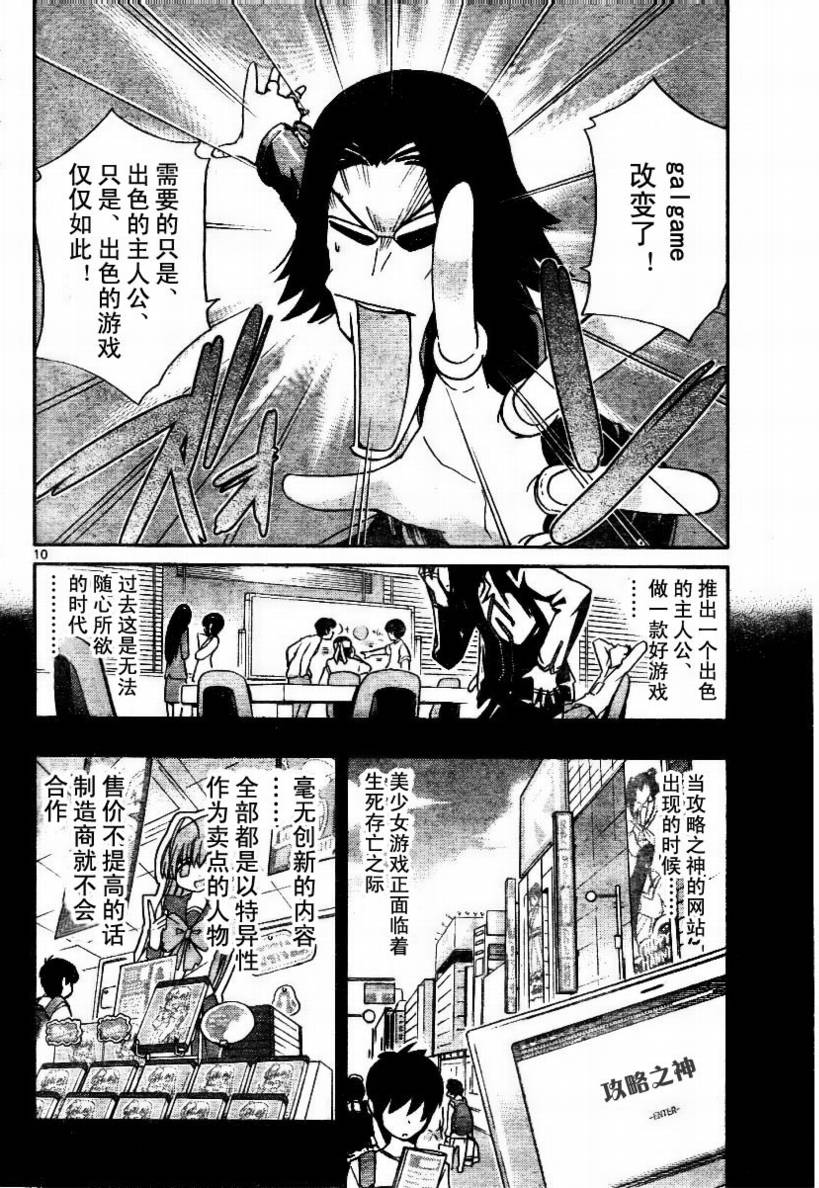
就技术角度而言,AVG开发可以算得所有游戏类型中最容易的。一款简单AVG游戏的制作难度甚至在贪食蛇、俄罗斯方块之下。由于实现的简易性,导致AVG的开发重心往往着重于策划及美工,程序员的作用则微乎其微。同时也正因AVG开发的门坎约等于0,所以此类型的同人游戏之多即可堪称世界之冠。另外,AVG开发工具普及的也促进了AVG的量产化。利用工具,即始是小说作者、漫画家等非软件专业出身的人士,往往也能轻易制作出顶级的AVG大作。(顺便一提,目前我所见过最好的AVG制作工具是鬼子的livemaker,采用类似思维导图的方式构造整个游戏,很多轻小说作者乃至网络漫画家用它制作自己作品的宣传游戏。但就技术角度上说,livemaker的开发依旧没什么难度......)
由于AVG的大泛滥,通常仅有文字、图片及语音的AVG往往无法满足用户需求(H除外-_-)。我们每每可在AVG游戏类型后发现个+号,比如《樱花大战》是AVG+SLG,《生化危机》是AVG+ACT。所以客观上说,AVG开发仅仅能进行字图的交互是不够的,还要解决多模块组件的协调问题。
在Java桌面应用开发中,我们都知道绘图是极为简单的,有Image、Graphics两个对象就可以Paint一个图形,即使图形对象再多,最后它们也必须统一在一个Paint中,所以Java中不存在图像的交互问题。
但问题在于,图像的显示可以统一,但是触发图像变化的事件却是很难统一的。比如现在有需求如下,在AVG模式中,触发键盘事件上、下、左、右时为控制画面的前进、后退,切换模式到SLG模式后,设定上、下、左、右是光标移动,那么如果我要在程序中实现,就必须记录当前模式,而后根据不同模式调用事件,再反馈到图形上。如果只有几个事件的区别,我们当然可以很容易用分支来实现;问题是,随着游戏规模的加大,这些分支将成几何倍数增多,单纯的分支判定到最后只能忙于应付,落个费力不讨好。
其实在这时,我们大可以使用一些技巧来轻松解决问题。
示例如下:
首先,我们构造一个接口,命名为IControl,继承鼠标及键盘监听,并在其中设定两个抽象方法:
package org.loon.simple.avg; import java.awt.Graphics; import java.awt.event.KeyListener; import java.awt.event.MouseListener; import java.awt.event.MouseMotionListener; /** * Copyright 2008 - 2009 * * Licensed under the Apache License, Version 2.0 (the "License"); you may not * use this file except in compliance with the License. You may obtain a copy of * the License at * * http://www.apache.org/licenses/LICENSE-2.0 * * Unless required by applicable law or agreed to in writing, software * distributed under the License is distributed on an "AS IS" BASIS, WITHOUT * WARRANTIES OR CONDITIONS OF ANY KIND, either express or implied. See the * License for the specific language governing permissions and limitations under * the License. * * @project loonframework * @author chenpeng * @email:ceponline@yahoo.com.cn * @version 0.1 */ public interface IControl extends MouseListener, MouseMotionListener, KeyListener { public abstract void draw(final Graphics g); public abstract IControl invoke(); }
而后,再构造一个接口,命名为IAVG,同样继承鼠标及键盘监听,并在其中设定三个抽象方法,用以操作IControl接口:
package org.loon.simple.avg; import java.awt.Graphics; import java.awt.event.KeyListener; import java.awt.event.MouseListener; import java.awt.event.MouseMotionListener; /** * Copyright 2008 - 2009 * * Licensed under the Apache License, Version 2.0 (the "License"); you may not * use this file except in compliance with the License. You may obtain a copy of * the License at * * http://www.apache.org/licenses/LICENSE-2.0 * * Unless required by applicable law or agreed to in writing, software * distributed under the License is distributed on an "AS IS" BASIS, WITHOUT * WARRANTIES OR CONDITIONS OF ANY KIND, either express or implied. See the * License for the specific language governing permissions and limitations under * the License. * * @project loonframework * @author chenpeng * @email:ceponline@yahoo.com.cn * @version 0.1 */ public interface IAVG extends MouseListener, MouseMotionListener, KeyListener { public abstract void draw(final Graphics g); public abstract IControl getControl(); public abstract void setControl(final IControl control); }
再后,制作一个显示图像用组件,命名为AVGCanva,继承自Canvas。
package org.loon.simple.avg; import java.awt.Canvas; import java.awt.Graphics; /** * Copyright 2008 - 2009 * * Licensed under the Apache License, Version 2.0 (the "License"); you may not * use this file except in compliance with the License. You may obtain a copy of * the License at * * http://www.apache.org/licenses/LICENSE-2.0 * * Unless required by applicable law or agreed to in writing, software * distributed under the License is distributed on an "AS IS" BASIS, WITHOUT * WARRANTIES OR CONDITIONS OF ANY KIND, either express or implied. See the * License for the specific language governing permissions and limitations under * the License. * * @project loonframework * @author chenpeng * @email:ceponline@yahoo.com.cn * @version 0.1 */ public class AVGCanvas extends Canvas { /** * */ private static final long serialVersionUID = 1982278682597393958L; private boolean start; private IAVG avg; public AVGCanvas(IAVG handler) { this.avg = handler; this.start = false; this.addKeyListener(handler); this.addMouseListener(handler); this.addMouseMotionListener(handler); } public void update(Graphics g) { paint(g); } public void paint(Graphics g) { if (this.start) { this.avg.draw(g); } } public void startPaint() { this.start = true; } public void endPaint() { this.start = false; } }
这段代码中的paint方法中并没有现成的方法,而是调用了IAVG接口的draw。紧接着,我们再设定一个AVGFrame用以加载AVGCanvas。
package org.loon.simple.avg; import java.awt.Color; import java.awt.Dimension; import java.awt.Frame; import java.awt.event.WindowAdapter; import java.awt.event.WindowEvent; /** * Copyright 2008 - 2009 * * Licensed under the Apache License, Version 2.0 (the "License"); you may not * use this file except in compliance with the License. You may obtain a copy of * the License at * * http://www.apache.org/licenses/LICENSE-2.0 * * Unless required by applicable law or agreed to in writing, software * distributed under the License is distributed on an "AS IS" BASIS, WITHOUT * WARRANTIES OR CONDITIONS OF ANY KIND, either express or implied. See the * License for the specific language governing permissions and limitations under * the License. * * @project loonframework * @author chenpeng * @email:ceponline@yahoo.com.cn * @version 0.1 */ public class AVGFrame extends Frame implements Runnable { /** * */ private static final long serialVersionUID = 198284399945549558L; private IAVG avg; private AVGCanvas canvas; private boolean fps; private String titleName; private Thread mainLoop; public AVGFrame(String titleName, int width, int height) { this(new AVG(), titleName, width, height); } public AVGFrame(IAVG avg, String titleName, int width, int height) { super(titleName); Lib.WIDTH = width; Lib.HEIGHT = height; this.avg = avg; this.titleName = titleName; this.addKeyListener(avg); this.setPreferredSize(new Dimension(width + 5, height + 25)); this.initCanvas(Lib.WIDTH, Lib.HEIGHT); this.pack(); this.addWindowListener(new WindowAdapter() { public void windowClosing(WindowEvent e) { System.exit(0); } }); this.setResizable(false); this.setLocationRelativeTo(null); this.setVisible(true); } public void run() { gameLoop(); } /** * 开始循环窗体图像 * */ private synchronized void gameLoop() { canvas.startPaint(); long second = 0L; int moveCount = 0; // 循环绘制 for (;;) { long start = System.currentTimeMillis(); this.paintScreen(); long end = System.currentTimeMillis(); long time = end - start; long sleepTime = 20L - time; if (sleepTime < 0L) sleepTime = 0L; try { Thread.sleep(sleepTime); } catch (InterruptedException e) { e.printStackTrace(); } if (this.fps) { moveCount++; second += System.currentTimeMillis() - start; if (second >= 1000L) { this.setTitle(new StringBuilder(titleName).append(" FPS:") .append(moveCount).toString()); moveCount = 0; second = 0L; } } } } /** * 启动游戏循环 * */ public void mainLoop() { this.mainLoop = new Thread(this); this.mainLoop.start(); } /** * 初始化背景帆布 * * @param width * @param height */ private void initCanvas(final int width, final int height) { canvas = new AVGCanvas(avg); canvas.setBackground(Color.black); canvas.setPreferredSize(new Dimension(width, height)); this.add(canvas); } public IAVG getAVG() { return this.avg; } protected void processWindowEvent(WindowEvent e) { super.processWindowEvent(e); } public synchronized void paintScreen() { canvas.repaint(); } public boolean isShowFPS() { return fps; } public void setShowFPS(boolean fps) { this.fps = fps; } public Thread getMainLoop() { return mainLoop; } public String getTitleName() { return titleName; } }
我们可以看到,在本例鼠标键盘事件及图像绘制完全通过接口方式实现。此时,只要让不同组件统一实现IControl接口,便可以轻松转换事件及图像的绘制。也正是我们都再熟悉不过的MVC模式中,通过Event导致Controller改变Model及View的基本原理。
下一回,我们将具体讲解一个AVG游戏实现的基本流程。
示例代码界面如下图:
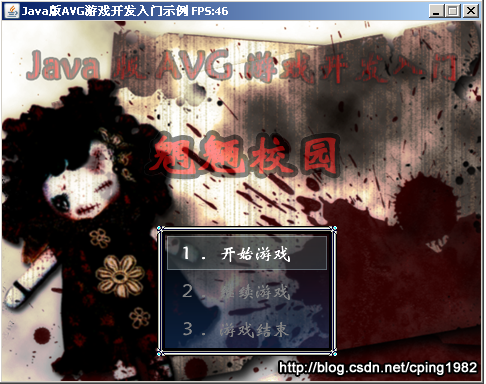
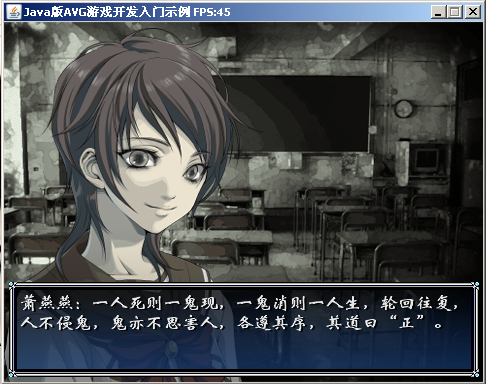
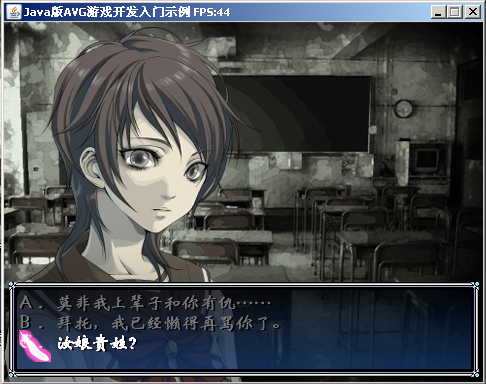
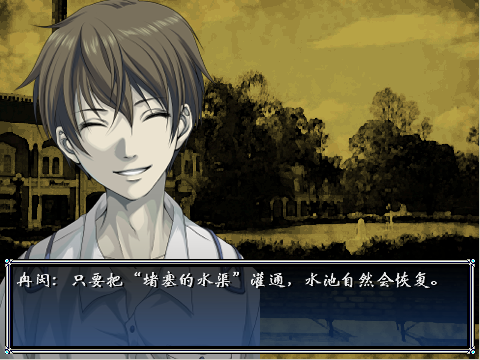
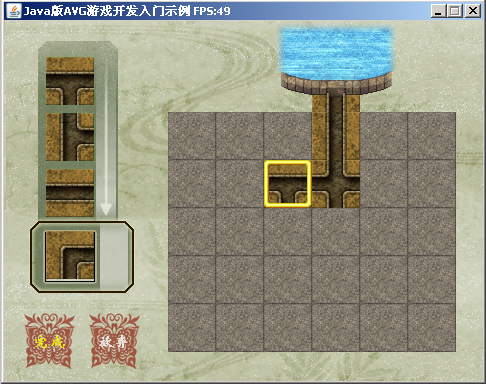 、
、
示例程序下载地址:http://download.csdn.net/source/999273(源码在jar内)




















 1493
1493

 被折叠的 条评论
为什么被折叠?
被折叠的 条评论
为什么被折叠?








